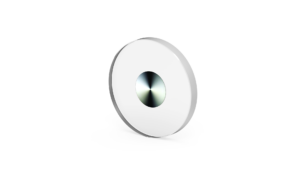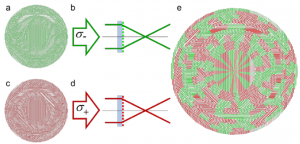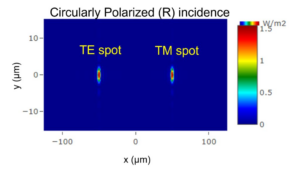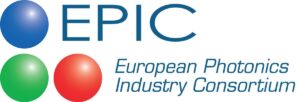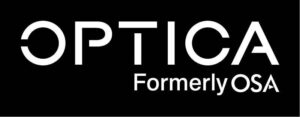The development of optics and photonics technology in areas such as sensing, telecom and display is on a constant quest for increasingly more compact and more performant assemblies. This article provides an overview of the various ways in which ultra-thin metasurfaces can be used to design compact beamshaping in various optical applications.
The advantages of metasurfaces for beamsteering are similar to those for lenses. First of all metasurfaces are ultra-thin. Their thickness is around the order of a wavelength or below. The wavefront can be controlled arbitrarily by selecting appropriate nano-structures. Second the spectral and polarization response can be engineered by modifying the constituent nanostructures. A plethora of nano-structures designs can be found and offer design freedom in tinkering with the dispersion, polarization conversion and selectivity. Finally, the number of components in an optical assembly can be reduced by combining the multiple functionalities in a single metasurface.
For high power applications metasurfaces with laser induced damage threshold exceeding conventional lenses have been shown (see for example this link).
Nevertheless, metasurfaces have a few disadvantages as well. The first demonstration of metalenses suffered from low efficiencies due to the use of plasmonic structures. This issue has been dramatically improved by the application of dielectric nano-structures. A further limitation is that like the related diffractive lenses metasurface have strong chromatic effects. It is remarkable that despite this inherent effect metalenses with nearly no chromatic aberration have been reported[1].
Similarly, the first metasurfaces were sensitive to angle of incidence. Strategies to create wide FOV metasurfaces have since been devised either with single metasurfaces[2] or so called doublets[3], a single substrate with a metasurface on either side.
While these drawbacks are definitely not yet solved problems their impact is limited in beamshaping applications where the FOV and spectral width are small.
The paragraphs below illustrate some of the recent realizations of metasurfaces for beamshaping applications.
Conventional and custom beam patterns
Like their diffractive counterparts, beamshaping metasurfaces are based on the principle of holographic control of the phase and amplitude. Two flavours of holographic control are possible. Either only the phase is controlled, with the amplitude being one (known as phase-only control) or both the phase and amplitude are individually controlled (known as Phase-Amplitude type).
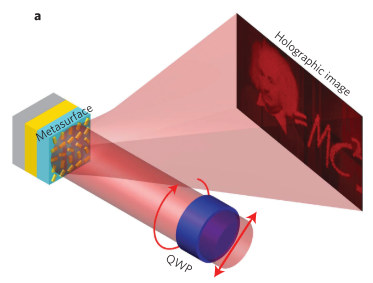
Arbitrary far field pattern generation with efficiencies up to 80% and bandwidth of 420 nm have been demonstrated experimentally using a phase-only metasurface design[4].
In a phase only near-field all incident light is transmitted (or reflected in the case of a reflected component) while in a phase amplitude type some of the incident light will be attenuated. This means that phase only holograms will be the preferred choice if maximum efficiency is needed.
On the other side of the trade-off Phase-amplitude holograms offer better control over the far-field profile and produce steeper drop-off in intensity and less speckle noise at the cost of lower efficiency.
The images below shows two experimentally recorded images left is a PA hologram which produces a better defined image, the right side image, whioch is made using the phase-only approach, is more intense (the scale bar is about 5 times higher) but the image suffers from speckle noise[5].

The extent of respectively efficiency loss and speckle noise in comparing PA and PO holograms is case dependent. A practical choice for PO or PA modulation should be made case-by-case.
The examples above show that an arbitrary field shape can be produced with a metasurface. For practical applications specific patterns like a top-hat (ideally a rectangular profile) or a Gaussian distribution are most interesting.
As an example of this the image below shows a Gaussian beam to top-hat converting metasurface. The top hat was designed using a phase only metasurface based on the geometric phase principle[6].
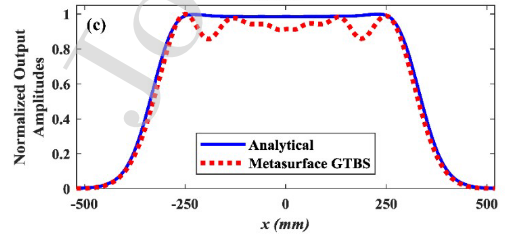
Multifunctional components for simplified assemblies
One of the most attractive aspects of metasurface is to combine the beamshaping functionality with for instance a phase plate or axicon required to make respectively vortex and Bessel beams. With conventional optics the collimation and conversion from for example an incident Gausian beam to a vortex beam (also called orbital angular momementum beam) would require both a lens and a phase plate.
The metasurface below combines these functionalities into one surface. The concentric rings appear from the collimating lens-like behaviour while the spiral distribution imparts the angular phase profile of the vortex[7].
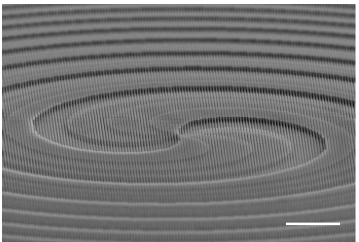
Another case of combining multiple functions in one metasurface is this multiplexing component. This metasurface was designed to simultaneously multiplex/de-multiplex different channels separated by both orbital angular momentum and wavelength[8].

Integrated and miniaturized optical systems
It’s also possible to combine miniaturization and multifunctional components. In the example below a collimating metalens was integrated at the output of a VCSEL cavity. Generally, the beam profile exiting a VCSEL device is diverging and an external lens is needed to collimate it. Using this integrated metalens, the beam exits the device without need for an external lens. This concept was taken a step further by also adding Bessel and OAM beam generation in the same metasurface[7].
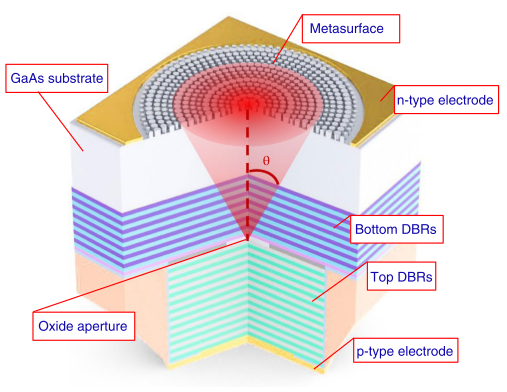
Apart from beamshaping purposes, metasurfaces also offer new possibilities for beam steering. Splitting a spectrum across a wide angular range with high efficiency usually requires multiple components. In the metagrating below[9], the spectrum was split over a range larger than ±40°. The metagrating acts as a blazed grating diffracting to positive angles for wavelengths over 700nm while wavelengths below 700nm are diffracted into the opposite direction. Effectively acting as if the component was rotated for those wavelengths.

The field of metasurfaces is still evolving rapidly and new concepts and applications are constantly popping up. It’s an exciting time to be part of this budding field. At PlanOpSim we focus on developing the design tools to help metasurface technology reach its full potential. PlanOpSim helps you to optimally apply metasurfaces for your projects with the help of its advanced design software.
More information & References
[1] W. T. Chen et al., “A broadband achromatic metalens for focusing and imaging in the visible,” Nat. Nanotechnol., vol. 13, no. 3, pp. 220–226, 2018.
[2] M. Y. Shalaginov et al., “A single-layer panoramic metalens with > 170° diffraction-limited field of view,” 2019.
[3] A. Arbabi, E. Arbabi, S. M. Kamali, Y. Horie, S. Han, and A. Faraon, “Miniature optical planar camera based on a wide-angle metasurface doublet corrected for monochromatic aberrations,” Nat. Commun., vol. 7, pp. 1–9, 2016.
[4] G. Zheng, H. Mühlenbernd, M. Kenney, G. Li, T. Zentgraf, and S. Zhang, “Metasurface holograms reaching 80% efficiency,” Nat. Nanotechnol., vol. 10, no. 4, pp. 308–312, 2015.
[5] A. C. Overvig et al., “Dielectric metasurfaces for complete and independent control of the optical amplitude and phase,” Light Sci. Appl., vol. 8, no. 1, 2019.
[6] A. Abbaszadeh, M. Ahmadi-Boroujeni, and A. Tehranian, “A compact polarization insensitive all-dielectric metasurface lens for Gaussian to tophat beam shaping in sub-terahertz regime,” Opt. Commun., vol. 462, p. 125313, 2020.
[7] Y. Y. Xie et al., “Metasurface-integrated vertical cavity surface-emitting lasers for programmable directional lasing emissions,” Nat. Nanotechnol., vol. 15, no. 2, pp. 125–130, 2020.
[8] Y. Li et al., “Orbital Angular Momentum Multiplexing and Demultiplexing by a Single Metasurface,” Adv. Opt. Mater., vol. 5, no. 2, 2017.
[9] Z. Li, E. Palacios, S. Butun, and K. Aydin, “Ultra-wide angle, directional spectrum splitting with visible-frequency versatile metasurfaces,” 2016 IEEE Photonics Conf. IPC 2016, pp. 388–389, 2017.

